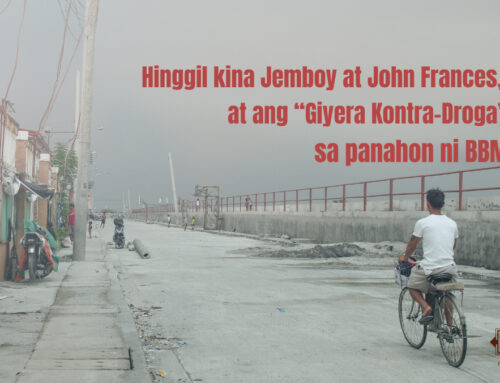Text and Photos by Isaiah Castro
When Arnel arrived in Bonbon in Aloguinsan town at the wake of typhoon Odette, he was a father fearing for his family of five, and a farmer holding on hope that he still has a livelihood to return to.
“No’ng dumating ako, nanlumo ako sa mga nakita ko sa paligid. ‘Di ko na makilala ang bayan ko. Di na ‘ko umasang nakatayo pa ang bahay ko,” he shared in Cebuano.
We caught up with Arnel at lunchtime, three days before the new year, working for a neighbor under the heat of the noontime sun. Facing Cebu’s west sea, his humble home was reduced to rubble and what little that remained of its concrete floor. What he was able to pick from the ruins, he has built into a makeshift shelter for his wife and children, the youngest a one-year-old. They evacuated to a more secure neighbor’s house to evade tragedy.
Arnel farms corn, bananas, and other crops for a living. In lean times, he goes fishing half a kilometer from the coast. While Arnel’s corn was harvested before the storm, strong winds pummeled his bananas and killed some of his livestock like a thief in the night, leaving barely anything behind.
Nonetheless, Arnel seemed spry for someone who hitchhiked and walked over 14 kilometers to reunite with his family and see for himself what they had lost. For Christmas, his family feasted on five kilos of rice that his wife won in a bingo game. Later on, he dolefully mutters, “Kung mauubos ‘yon, eh di wala na kaming makakain.”
Elsewhere, Arnel’s neighbors, his fellow members of the local farmers’ formation, complained of the meager supplies handed by the provincial government. The package consisted of two kilos of rice, allegedly riddled with dust and small pieces of stone, and broiler chicks which can only be harvested for meat after 45 days. The rest of the community wonders where the town’s calamity funds went.
Arnel’s story is but one glimpse of the vast agricultural damage wrough by typhoon Odette on small-scale plantations in Cebu, Bohol, and Negros island—all heavily reliant on farming industries of either corn, palay, sugarcane, coconuts, and bananas. Vegetable and backyard gardens were also decimated by strong winds, leaving peasant families to salvage what was left of deep-rooted crops like sweet potatoes. At the wake of the calamity, huge tree trunks, broken power lines, and other debris rendered farm-to-market roads impassable. In several rural areas in southern Cebu, stretching from Balamban to Dalaguete, townsfolk boil water from scanty deep wells for drinking water and domestic use.
In coastal areas, a storm surge brought seawater over a hundred meters on land since the typhoon’s peak hit during the high tide, destroying shelters made of light materials, fishponds, and livelihoods. These raise concerns on food security as Metro Cebu is dependent on agri- and aquaculture produce from the south.
“Pumunta kami sa evacuation center at doon salo-salo nalang kami sa pagkain,” Maria Luz, a chairperson of a local fisherfolk formation in Talisay City, recounted in Cebuano of their situation directly after Odette. “Sirang-sira ang bahay namin. Walang bubong, walang haligi. Kapag uulan, dadagsa kami sa kapilya.”
Having stood her ground against demolitions since her community was evicted for the construction of the South Road Properties reclamation in Cebu City, Maria Luz is no stranger to displacement but hopes every time to be her last. Around her, children play without worry around bent GI sheets, worn-out fishing boats, and decaying scraps of wood. The adults, on the other hand, argue on what they perceive to be unequal treatment from the village chief during relief distributions.
When asked what lessons she learned anew from Odette, Maria Luz’s reply was short and straightforward: “Litong-lito na kami kung paano maghanda.”
Earlier this month, the Department of Agriculture (DA) Disaster Risk Reduction and Management Operations Center revealed initial estimates that Odette-inflicted agricultural damage reached as high as Php 11.1 billion, with most of the damage incurred by the fisheries, rice, coconut, and sugarcane-producing sectors. So far, the DA noted () at least 389,316 farmers and fisherfolk in Calabarzon, Mimaropa, Bicol, Western Visayas, Central Visayas, Eastern Visayas, Zamboanga peninsula, Northern Mindanao, Davao, Soccsksargen and Caraga and 420,465 hectares of agricultural land affected by typhoon Odette. Moreover, the Cebu Provincial Police Office and local disaster management offices have reported at least 112 Cebuano deaths. The true numbers could easily be higher. Comprehensive data and situational reports, especially on agricultural damage, from the Provincial Disaster Risk Reduction Management Office (PDRRMO) are still insufficient to date.
Given the continuing threat of the COVID-19 pandemic, civic groups have advocated for special attention on issues of food security, health, water and sanitation, and shelter and livelihood. Alongside demands of genuine agrarian reform and support to strengthen resiliency of the national agricultural infrastructure, the clamor for aid and programs for relief and rehabilitation services remains high.
On December 17, a day after Odette’s onslaught, President Rodrigo Duterte announced that government coffers have already been “immensely depleted” by pandemic response, although he assured that he is trying to look for funds for Odette victims. Critics branded this as severely “bad prioritization” of the budget’s emergency funds, and ironic still, since the Duterte administration is the World Bank’s biggest borrower in 2021 with US$3.07 billion. Fear of further public ire may have compelled authorities to act fast on the matter, as Duterte himself instructed on December 28 that the government provide Php 5,000 in cash aid and shelter assistance per family displaced by Odette, channeled through local government units and supervised by the Department of Interior and Local Government.
Cebuano survivors, like the rest of the country, wait for the program to go full-swing, especially in far-flung areas. And their satisfaction matters, as the province holds the largest number of voters for the 2022 polls and may turn the tides for or against leading national candidates.
Beyond the ballot, however, the tragedy of Odette and all other typhoons that Filipinos have endured and will endure call for a movement to “build back better” and safer. The government must lead rehabilitative and recovery efforts, with affirmative consideration for the most vulnerable sectors and an objective to improve the country’s agricultural ownership and infrastructure to protect the most basic sectors from disaster risks and incessant loss of livelihood.
Until then, Arnel, Maria Luz, and their families will have to scour all means for their next meal. This is what the middle and upper-classes tout as Filipino resiliency to the rest of the world. However, what is resiliency here but mere survival instincts spurring into action?
***
For individuals and organizations who wish to donate or coordinate for relief operations, you may reach out to the Cebubohol Relief and Rehabilitation Center at Cebubohol1987@gmail.com. Youth formations under the Alibyo Cebu Ayuda Network are also accepting cash donations via GCash at 09360758493 (Aura Mae A.) and BPI account number 3619182633 (Sta. Ana B. Aures).











